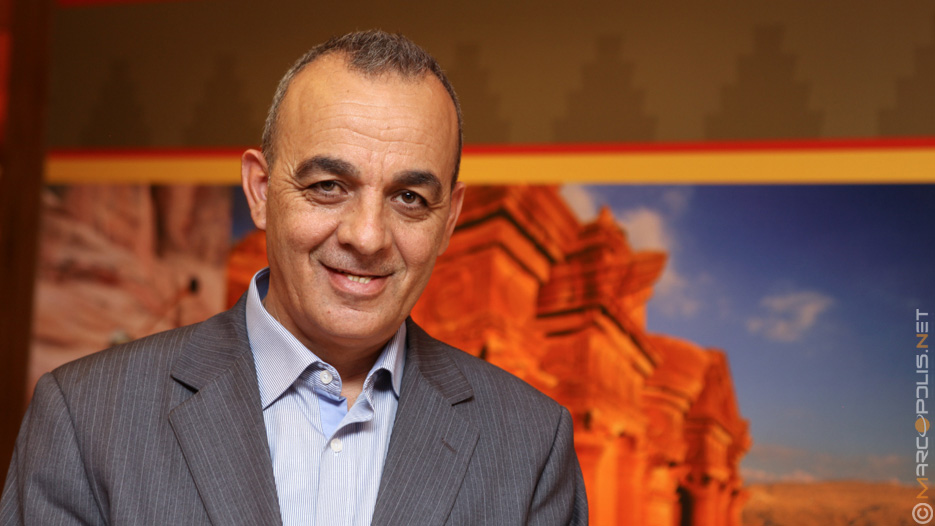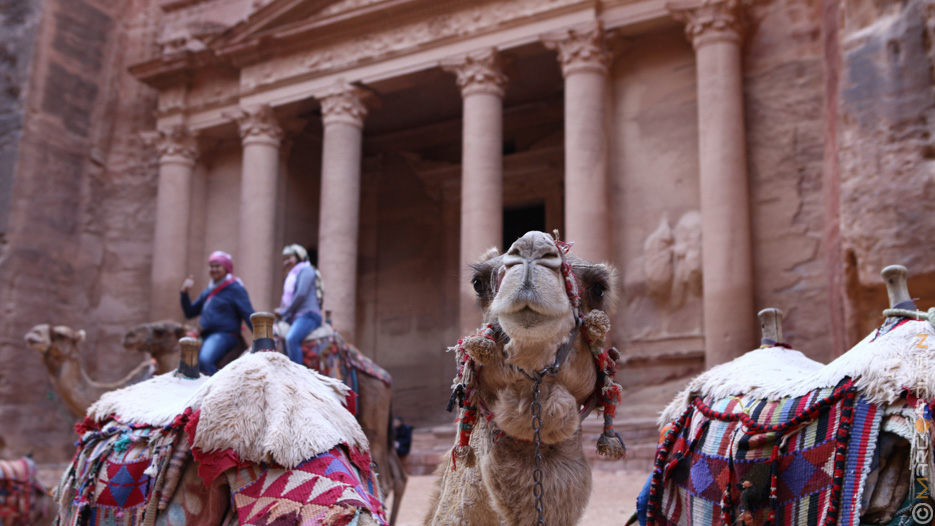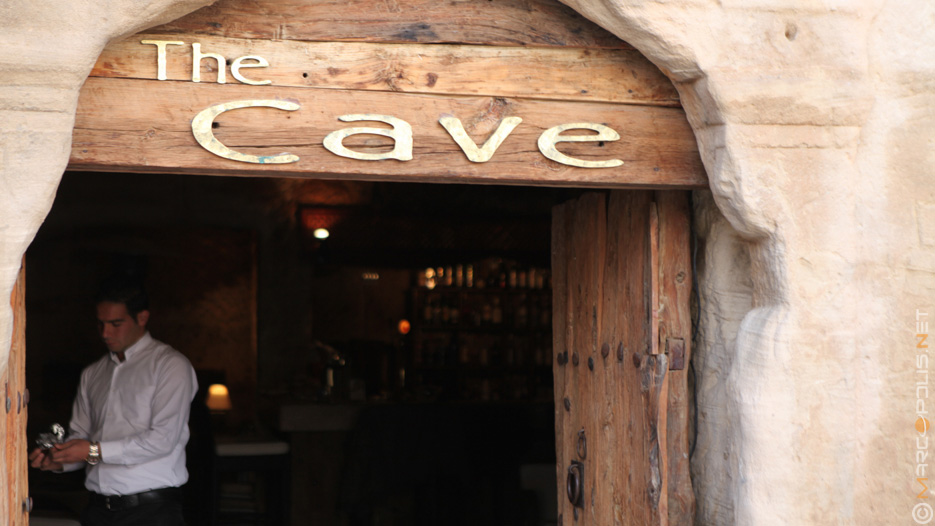Petra Authority: “We Don’t Want Petra to Be a Mass Tourism Destination but an Experience of Culture”
“We want it to be a unique experience because Petra is a unique place, there is no other place like Petra in the world and so that is why we want the uniqueness reflected in the experience of Petra.”
Interview with Dr. Emad Hijazeen, Deputy Chief Commissioner & Petra Archaeological Park Commissioner of Petra Authority (PDTRA)

Give us an evaluation of the tourism sector in Jordan amidst the current regional situation.
As a matter of fact, Jordan’s tourism has been suffering since the start of the Arab Spring in 2011. We have witnessed a sharp decrease since then but frankly speaking in the last year we have seen more tourism than what we did in the years immediately following 2011. In 2014 we started to recover somewhat until towards the end of the year when there was another unfortunate fall in numbers particularly due to the war against ISIS. This has really caused a sharp decline in tourists to Petra particularly. If we talk about tourism in Jordan, we have to differentiate between two types of tourists, we have international tourists who generally come to our archaeological sites like Petra, the Dead Sea, Aqaba etc. and we have the domestic tourists who are mainly interested in Amman, Aqaba and maybe the Dead Sea.
Could you specify the number of tourists?
The average number of international tourists in the past 4 years used to be around half a million with about 100,000 domestic and Arab tourists. This year it will be a little bit less; we will probably attract around 400,000 tourists.

You are overseeing the development not only in the city of Petra but also the region as a whole. What would you identify as the main investment opportunities in Jordan?
The most promising areas to invest in Jordan are tourism and the IT sector. These are areas that His Majesty is promoting. We also have the pharmaceutical industry. Then there are small production areas for example fertilisers. However I would say that the three main areas are tourism, IT and pharmaceuticals.
How would you summarise the development in the region over the past year? What have been the highlights in terms of the archaeological park?
In the past four years, we have been working on developing a strategic master plan for Petra. Through this we have finalised which projects will be contracted and what type of investment could help us in order not only to attract tourists but to present Petra as a world class destination. I would really emphasise that we don’t want Petra to be a mass tourism destination; we want it to be a place for everyone who wants to experience culture, whether it be the old or the modern culture of Petra. We want it to be a unique experience because Petra is a unique place, there is no other place like Petra in the world and so that is why we want the uniqueness reflected in the experience of Petra. In 2016 we will start implementing this vision of our master plan in terms of having new products that complement the visit to the park. Nowadays unfortunately many people who come to Petra think that there is just the Petra Treasury which is not true. In fact Petra covers 264km2. It is a very rich place with natural and cultural assets. It also has the local people who continue the culture and history of Petra. We have focused on this and we want to present Petra with these three components: nature, culture and the local community. We want to present a real experience that can mix the people, the site and the tourists all together in one product.
Nowadays unfortunately many people who come to Petra think that there is just the Petra Treasury which is not true. In fact Petra covers 264km2.
You said that you have a master plan and that you have identified certain services that need to be implemented in order to give the visitor an overall package with added value. What services will you be introducing in 2016?
We have defined two types of projects. One is inside the park and the other is outside of the park. Inside the park we are not going to introduce any new services except what we call the “back exit road”. Tourists nowadays come and go the same way and most of them are of a certain age and it can be hard for them to come back the same way. We also thought that tourists can spend the time walking and seeing more things inside the park because the park is huge and so you need at least three or four days to explore it. This “back exit road” will help tourists see and enjoy more and it will mean they can stay more days because we need people to stay and enjoy more because Petra is not a visit to be done in one or two hours. Petra is a place where people want to go and experience other cultures. Outside of the park in our master plan we have defined a buffer zone for the park in order to protect it from future urban encroachment or development and then we have defined the development areas. Within the buffer zone area we have also defined some services, for example we are going to have the Petra Cultural Village and in this village we are going to group all of the kiosks and concessions together in one place so the park shall be left as a place purely to enjoy, experience, meditate and pray. When the tourists are finished they will be picked up with an eco-shuttle system and taken to this place where they can have real contact and experience with the locals. It will be open 24 hours and then the tourists can return to their hotels whenever they like. We are also going to have other experiences during the night. In 2016 we are going to start construction of a new museum and then we have other projects for the downtown of Petra where we have an old Ottoman Village that we call LG Village. We will have activities in all of these places so that tourists can enjoy the visit of the park and then also something to do after the park. At the moment tourists after visiting the park aren’t sure what to do in the evening. As a matter of fact when we talk about Petra we talk about cultural tourism but unfortunately up until now we are really just talking about a visit to an archaeological site, not a fully cultural visit. The tourists don’t see any art or folklore performances in the area after their visit just yet.

Brief us on the Petra Museum Project and your cooperation with the Japan International Cooperation Agency (JICA).
This project is funded by the JICA and we hope that the museum will be an added value to the visit to Petra. Normally museums are the memory of a place and of a people. Again, the park is huge and to tell you the truth most of our tourists see just 3 to 5% of the park. Many don’t know about the Monastery, the neo-lithic site, or the Crusader for example. In the museum we want to give the tourists an overview of the park. We want to tell them that Petra is not just the Treasury. Petra is beyond that. That is why we hope that the museum will also be a tool for us to help the visitors better understand the park and also to engage them in our efforts for protecting Petra and presenting it in a better way.
What is the significance of the agreement between the Authority and the Turkish Airlines?
I am the one who signed the agreement with the Turkish Airlines. We think that Petra is not marketed correctly. There are many reasons for this: the lack of resources or qualified persons, networking etc. It is a privilege for us to partner with an airline such as Turkish Airlines for many reasons but particularly because it is one of the most successful airlines worldwide nowadays; for the past five years they have been voted the top European airline for example. They are also the only regular airline that flies to Jordan, to both Amman and to Aqaba. This helps us to present a tourism product that not only covers Petra but the whole of Jordan including what we call “the golden triangle,” i.e. Petra, Wadi Rum and Aqaba. From this point, we went into a partnership in terms of marketing and we hope it will help us to reach all of the destinations that Turkish Airlines fly to. I believe they fly to more than 260 destinations worldwide so it is a privilege for us and indeed a win-win situation for both of us.
Will you be holding any events in the near future that you would like to promote?
We are finalising our calendar of events for 2016. I shall focus on two major events that I hope to conduct in 2016. One shall be either in March or April. In the past month, in cooperation with the UNESCO Amman office, Talal Abu-Ghazaleh Organisation and the Jordan Orchestra we have invited a very important trumpet musician from Italy to record Petra’s Melody. In March we are going to host and invite all of the international ambassadors to Jordan and we shall hopefully receive a very important patronage (not confirmed yet). At this event we shall launch this first initiative to do with music and the melodies of Petra. This event is very important for many reasons, first of all music is a language that everybody understands. As I said before, when we talk about Petra we want to talk about art and culture, so this is the first time that we shall be promoting art and culture. Also it is a sign to the world that Petra is safe and it is beautiful. Petra has always been, from the beginning, a metropolitan city. That is why we want to host all of the ambassadors to promote Petra because Petra can host many ambassadors and foreign businessmen. This is our message with this event.
The second major event is in August. We are going to revitalise the Petra Cultural Festival with art and folklore from Jordan and from abroad as well.
What is your vision for Petra?
My wish and vision for Petra is for it to be a world class destination available to everybody who wants to know, understand and experience this culture that is over 2,000 years old. Petra may have been marginalised in the past and it still very much remains a mystery. We need to look at how we can protect it and how we can present it to the people, because if we lose it, we will have lost it forever. It is a very fragile and fine asset. Secondly we need to look at how we can discover more of it. If you visit it you will see that in the Treasury there are two storeys and it is most likely that if we excavate more you will discover much more than that because we believe that we have only just uncovered 15 to 20% of Petra. You can imagine how much more there is to discover, but before we do that we have to prepare ourselves so that we can preserve all of it for future generations.
FAIR USE POLICY
This material (including media content) may not be published, broadcasted, rewritten, or redistributed. However, linking directly to the page (including the source, i.e. Marcopolis.net) is permitted and encouraged.